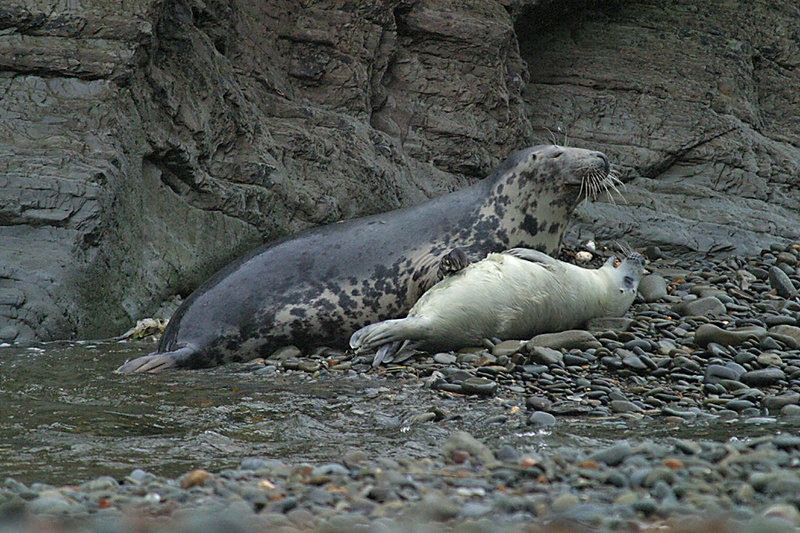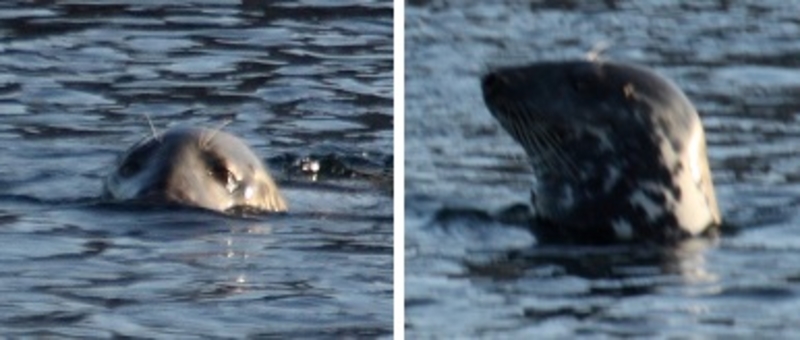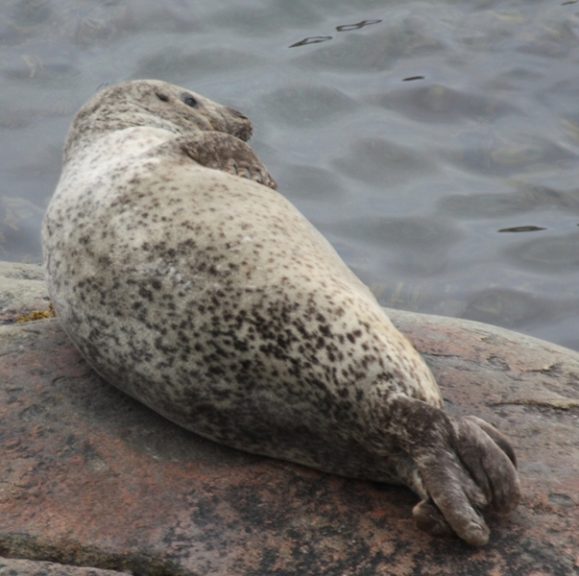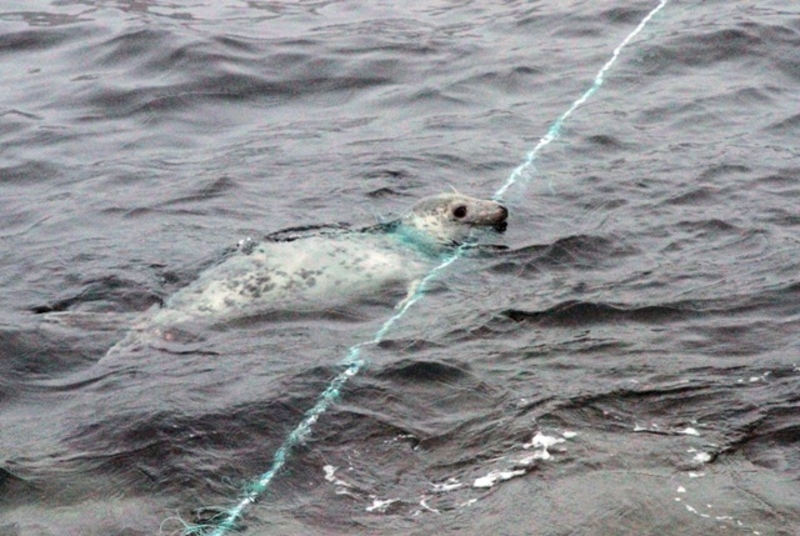Grey seal

Grey seal with pup in Wales. Notice the long snout. Photo: Fernando Ugarte
Halichoerus grypus
Size
The grey seal is a relatively large seal. In the eastern Atlantic, the average male is about 2m long and can reach a maximum weight of just over 300kg. Females are 1.8m on average and can reach a weight of between 150 and 200kg. In the western Atlantic, males are 2.25m on average and can reach a maximum weight of just over 400kg, while females will average 2m and can be up to 250kg.
Food
The grey seal mainly eats fish. It can be both larger fish, such as cod and salmon, or smaller fish, such as capelin and sand lance.
Reproduction
The time of birth can vary from late September to early March, depending on the population in question. The breeding habitat, i.e. those places where the grey seal gives birth to her pups, can also vary. Grey seals breed in caves (the Faroe Islands, Scotland and Wales), on rocky islets (Iceland, Norway and some of the British Isles) and ice (in the Baltic and near Canada). Some grey seals therefore breed relatively dispersed, while others give birth in very dense colonies.
Grey seals were observed in Greenland with certain for the first time in 2009. We do not yet know where the Greenland grey seal comes from. Nor do we know for sure if they breed in Greenland, but in September 2010, researchers from the Greenland Institute of Natural Resources and NERI (the Danish National Environmental Research Institute at Aarhus University) caught a one year-old pup in the same place where the first two sightings of grey seals in Greenland were made in 2009. Maybe the youngster was born in Greenland. In any case, it is an indication that grey seals might have been breeding in Greenland.
Moulting
The moulting period is usually around 3-4 months after the birthing period. In the eastern Atlantic, it is typically from January to April, while in the western Atlantic and the Baltic, it is usually in May-June.
Distribution and numbers

Grey seal in the water in August 2009. Photo Aqqalu Rosing-Asvid

This may be a young grey seal (August 2009). The spotted skin reminds of both some types of common seals (a.k.a. harbour seal) and some grey seals, but the shape of the head (forehead and nose that merge in one) most closely resembles the grey seal. Photo: Aqqalu Rosing-Asvid
The grey seal has never with certainty been observed in Greenland before the autumn of 2009. Otto Fabricius, who was a missionary and zoologist and lived in Greenland from 1768 to 1773, writes that the Greenlandic hunters talked about a seal called sigguttooq (the long snouted) which would be a very appropriate name for the grey seal. He never saw it in Greenland and he never met a hunter who had caught one of these seals. However, he talked with several who claimed to have seen it and he was in no doubt that it existed, but he concluded that it must be very rare.
About 100 years later, the Scottish explorer Robert Brown claimed that a skull from a seal caught in Disko Bay was from a grey seal. Unfortunately, this skull was destroyed by a polar bear cub which he had on board his ship. Some years later (in 1867), he claims to have seen skins from grey seals, also in Disko Bay. Contemporary trading managers do not mention anything about grey seals. In 1902, Herluf Winge describes Greenland mammals and he refers to Brown, but not to Brown’s description of the grey seal. He is apparently not completely convinced of its correctness.
The grey seal has probably visited Greenland now and then, and now that Inuit hunters have become aware of this seal species, there are some who think they have seen them in southern Greenland. However, no skins or bones of the grey seal have been found, neither in archaeological digs nor otherwise.
In August 2009, the grey seal was certainly seen and photographed just north of Cape Farewell and, in September 2010, a year-old grey seal pup was trapped and had a transmitter attached (see section on research).
Related links:
Grey seal documented for the first time in Greenland 5/11/2009
Status
Up until now, 2-3 different individuals have certainly been seen, but there might be many more. The current status is actually unknown, but one must assume that grey seals are few in number and that, in total, there are less than 250 adult individuals, which in the Greenland Red List means they are assigned to the category of “critically endangered”.
Management
Whether or not these seals establish a population in Greenland, only time will tell. How predisposed they are to adapt to their environment will also be of great importance. Grey seals in different part of the North Atlantic have different timing of the breeding season, and some give birth singly others in colonies, and some breed in caves, others on rocks or on ice. So which group of grey seals they come from may be of crucial importance for their success in Greenland.
There is no international governing body that manages grey seals, but NAMMCO has established a working group that can give advice on capture and management of coastal seals (habour seals and grey seals).
The grey seal is totally protected in Greenland.
Research

Grey seal pup caught in net. Photo: Aqqalu Rosing-Asvid
In September 2010, a year-old pup was caught at Cape Farewell and had a satellite transmitter attached. Normally, such transmitters last for around a year. For unknown reasons however, this transmitter stopped sending after only a few months. By that time, the seal had swum a couple of hundred kilometres up the east coast.
You can read more HERE

